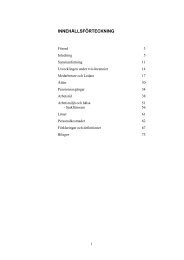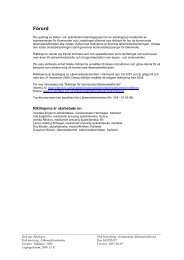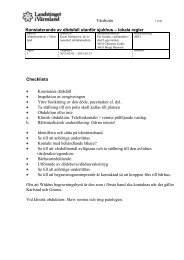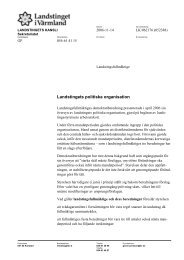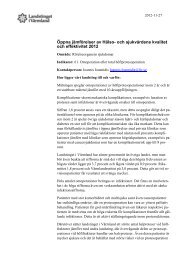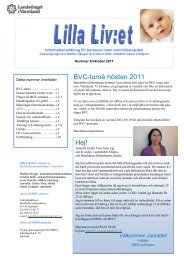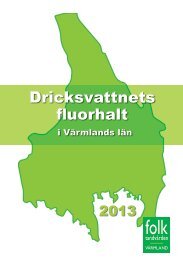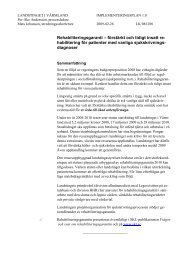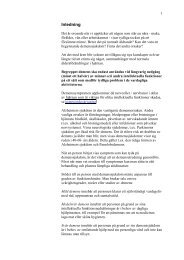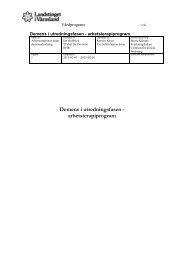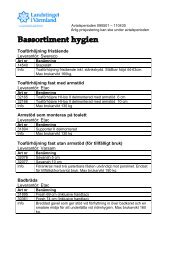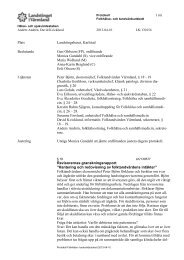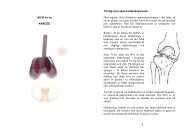Advances in Physiotherapy “I got knowledge of myself and my ...
Advances in Physiotherapy “I got knowledge of myself and my ...
Advances in Physiotherapy “I got knowledge of myself and my ...
Create successful ePaper yourself
Turn your PDF publications into a flip-book with our unique Google optimized e-Paper software.
This article was downloaded by: [Marklund, Ingela]<br />
On: 27 November 2009<br />
Access details: Access Details: [subscription number 913652520]<br />
Publisher Informa Healthcare<br />
Informa Ltd Registered <strong>in</strong> Engl<strong>and</strong> <strong>and</strong> Wales Registered Number: 1072954 Registered <strong>of</strong>fice: Mortimer House, 37-<br />
41 Mortimer Street, London W1T 3JH, UK<br />
<strong>Advances</strong> <strong>in</strong> <strong>Physiotherapy</strong><br />
Publication details, <strong>in</strong>clud<strong>in</strong>g <strong>in</strong>structions for authors <strong>and</strong> subscription <strong>in</strong>formation:<br />
http://www.<strong>in</strong>formaworld.com/smpp/title~content=t713691431<br />
<strong>“I</strong> <strong>got</strong> <strong>knowledge</strong> <strong>of</strong> <strong><strong>my</strong>self</strong> <strong>and</strong> <strong>my</strong> prospects for lead<strong>in</strong>g an easier life”:<br />
Stroke patients' experience <strong>of</strong> tra<strong>in</strong><strong>in</strong>g with lower-limb CIMT<br />
Ingela Marklund abc ; Maria Klässbo d ; Birgitta Hedel<strong>in</strong> ef<br />
a Department <strong>of</strong> <strong>Physiotherapy</strong>, Torsby Hospital, Sweden b Research Centre for Primary Care,<br />
Värml<strong>and</strong> County Council, Karlstad, Sweden c Department <strong>of</strong> Community Medic<strong>in</strong>e <strong>and</strong><br />
Rehabilitation, Umeå University, Sweden d Centre for Cl<strong>in</strong>ical Research, Värml<strong>and</strong> County Council,<br />
Karlstad, Sweden e Department <strong>of</strong> Nurs<strong>in</strong>g, Gjövik University College, Gjövik, Norway f Department<br />
<strong>of</strong> Nurs<strong>in</strong>g Science, Karlstad University, Karlstad, Sweden<br />
First published on: 04 August 2009<br />
To cite this Article Marklund, Ingela, Klässbo, Maria <strong>and</strong> Hedel<strong>in</strong>, Birgitta(2009) '<strong>“I</strong> <strong>got</strong> <strong>knowledge</strong> <strong>of</strong> <strong><strong>my</strong>self</strong> <strong>and</strong> <strong>my</strong><br />
prospects for lead<strong>in</strong>g an easier life”: Stroke patients' experience <strong>of</strong> tra<strong>in</strong><strong>in</strong>g with lower-limb CIMT', <strong>Advances</strong> <strong>in</strong><br />
<strong>Physiotherapy</strong>,, First published on: 04 August 2009 (iFirst)<br />
To l<strong>in</strong>k to this Article: DOI: 10.1080/14038190903141048<br />
URL: http://dx.doi.org/10.1080/14038190903141048<br />
PLEASE SCROLL DOWN FOR ARTICLE<br />
Full terms <strong>and</strong> conditions <strong>of</strong> use: http://www.<strong>in</strong>formaworld.com/terms-<strong>and</strong>-conditions-<strong>of</strong>-access.pdf<br />
This article may be used for research, teach<strong>in</strong>g <strong>and</strong> private study purposes. Any substantial or<br />
systematic reproduction, re-distribution, re-sell<strong>in</strong>g, loan or sub-licens<strong>in</strong>g, systematic supply or<br />
distribution <strong>in</strong> any form to anyone is expressly forbidden.<br />
The publisher does not give any warranty express or implied or make any representation that the contents<br />
will be complete or accurate or up to date. The accuracy <strong>of</strong> any <strong>in</strong>structions, formulae <strong>and</strong> drug doses<br />
should be <strong>in</strong>dependently verified with primary sources. The publisher shall not be liable for any loss,<br />
actions, claims, proceed<strong>in</strong>gs, dem<strong>and</strong> or costs or damages whatsoever or howsoever caused aris<strong>in</strong>g directly<br />
or <strong>in</strong>directly <strong>in</strong> connection with or aris<strong>in</strong>g out <strong>of</strong> the use <strong>of</strong> this material.
Downloaded By: [Marklund, Ingela] At: 07:14 27 November 2009<br />
<strong>Advances</strong> <strong>in</strong> <strong>Physiotherapy</strong><br />
2009, 1 8, iFirst article<br />
ORIGINAL ARTICLE<br />
‘‘I <strong>got</strong> <strong>knowledge</strong> <strong>of</strong> <strong><strong>my</strong>self</strong> <strong>and</strong> <strong>my</strong> prospects for lead<strong>in</strong>g an easier<br />
life’’: Stroke patients’ experience <strong>of</strong> tra<strong>in</strong><strong>in</strong>g with lower-limb CIMT<br />
INGELA MARKLUND 1 , MARIA KLÄSSBO 2 & BIRGITTA HEDELIN 3<br />
1 Department <strong>of</strong> <strong>Physiotherapy</strong>, Torsby Hospital, Sweden, Research Centre for Primary Care, Värml<strong>and</strong> County Council,<br />
Karlstad, Sweden <strong>and</strong> Department <strong>of</strong> Community Medic<strong>in</strong>e <strong>and</strong> Rehabilitation, Umea˚ University, Sweden, 2 Centre for<br />
Cl<strong>in</strong>ical Research, Värml<strong>and</strong> County Council, Karlstad, Sweden, 3 Department <strong>of</strong> Nurs<strong>in</strong>g, Gjövik University College, Gjövik,<br />
Norway <strong>and</strong> Department <strong>of</strong> Nurs<strong>in</strong>g Science, Karlstad University, Karlstad, Sweden<br />
Abstract<br />
Rehabilitation after stroke has changed <strong>and</strong> more studies with <strong>in</strong>tensive therapy have been conducted. When a new<br />
method here lower-limb constra<strong>in</strong>t-<strong>in</strong>duced movement therapy (CIMT) is <strong>in</strong>troduced, it is important to <strong>in</strong>vestigate<br />
participants’ own experience <strong>of</strong> the therapy. The present purpose was accord<strong>in</strong>gly to describe stroke patients’ experience <strong>of</strong><br />
tra<strong>in</strong><strong>in</strong>g with lower-limb CIMT. Qualitative <strong>in</strong>terviews with seven stroke patients who had participated <strong>in</strong> lower-limb CIMT<br />
were conducted. The <strong>in</strong>terviews were transcribed verbatim <strong>and</strong> analysed with qualitative content analysis. One theme,<br />
<strong>knowledge</strong> <strong>of</strong> <strong><strong>my</strong>self</strong> <strong>and</strong> <strong>my</strong> prospects for lead<strong>in</strong>g an easier life, emerged. Two ma<strong>in</strong> categories were found: the therapy <strong>and</strong> me <strong>and</strong><br />
<strong>my</strong> body, with four <strong>and</strong> three categories respectively. The therapy comprised the <strong>in</strong>formants’ experience <strong>of</strong> preparation for<br />
CIMT, the actual <strong>in</strong>tensive tra<strong>in</strong><strong>in</strong>g <strong>and</strong> its effects, <strong>and</strong> their views on the physiotherapists <strong>in</strong>volved. Me <strong>and</strong> <strong>my</strong> body<br />
comprised the <strong>in</strong>formants’ reflections on their own significance for the therapy, how the reflections had affected them <strong>and</strong><br />
what <strong>in</strong>sight <strong>in</strong>to their condition CIMT had given. The <strong>in</strong>formants reported that CIMT for the lower extremity gave them<br />
<strong>knowledge</strong> <strong>of</strong> their body <strong>and</strong> their prospects for lead<strong>in</strong>g an easier life. The <strong>in</strong>tensive tra<strong>in</strong><strong>in</strong>g <strong>in</strong>stilled hope, s<strong>in</strong>ce the<br />
functional improvements showed the possibilities <strong>of</strong> improvements, <strong>in</strong>creas<strong>in</strong>g the respondents’ <strong>in</strong>dependence <strong>and</strong> selfesteem.<br />
Even though the <strong>in</strong>tensive tra<strong>in</strong><strong>in</strong>g is tough, it was experienced as entirely necessary.<br />
Key words: Stroke, physiotherapy, Constra<strong>in</strong>t-<strong>in</strong>duced movement therapy, qualitative content analysis<br />
Introduction<br />
Stroke is among the most common causes <strong>of</strong> <strong>in</strong>validity<br />
<strong>in</strong> Sweden. With lengthen<strong>in</strong>g life expectancy <strong>and</strong><br />
survival after earlier stroke, the prevalence is <strong>in</strong>creas<strong>in</strong>g<br />
(1). The situation is <strong>of</strong> great importance <strong>in</strong> the<br />
community <strong>and</strong> similar <strong>in</strong> many western countries.<br />
Constra<strong>in</strong>t-<strong>in</strong>duced movement therapy (CIMT) is<br />
an approach <strong>in</strong> stroke rehabilitation, developed by<br />
Taub & Wolf (2). It targets motor recovery by<br />
limit<strong>in</strong>g the use <strong>of</strong> the unaffected limb <strong>and</strong> promot<strong>in</strong>g<br />
normal co-ord<strong>in</strong>ated movement <strong>of</strong> the affected<br />
limb through massed practice. The therapy <strong>in</strong>volves<br />
plac<strong>in</strong>g the unaffected upper extremity <strong>in</strong> a sl<strong>in</strong>g <strong>and</strong><br />
target<strong>in</strong>g tra<strong>in</strong><strong>in</strong>g <strong>of</strong> the affected upper extremity 6 h/<br />
day for 2 weeks (2 4). Studies show that CIMT can<br />
improve activities <strong>of</strong> daily liv<strong>in</strong>g (ADL), <strong>and</strong> that<br />
these improvements persist at follow-up 2 years after<br />
completed CIMT. The bra<strong>in</strong>’s plastic ability has<br />
been <strong>in</strong>vestigated <strong>in</strong> connection with <strong>in</strong>tensive tra<strong>in</strong><strong>in</strong>g<br />
<strong>and</strong> is considered to play a part <strong>in</strong> expla<strong>in</strong><strong>in</strong>g the<br />
effect <strong>of</strong> CIMT (2,5 7).<br />
Formerly, when a person with stroke has arrived at<br />
a plateau <strong>of</strong> functional recovery, it was hard to<br />
achieve further improvements. However, Page et al.<br />
(8) considered that this should be reassessed.<br />
Instead, rehabilitation <strong>in</strong>terventions should be reviewed<br />
regard<strong>in</strong>g their <strong>in</strong>tensity, <strong>and</strong> tra<strong>in</strong><strong>in</strong>g should<br />
be more varied to overcome learned movement<br />
patterns. Kwakkel et al. (9) showed <strong>in</strong> their review<br />
article that <strong>in</strong>tensity, def<strong>in</strong>ed <strong>in</strong> time, is significant.<br />
Higher therapy <strong>in</strong>tensity gave better results <strong>in</strong> ADL<br />
<strong>and</strong> <strong>in</strong> neuromuscular function.<br />
How people with stroke experience CIMT is still<br />
unknown. In one article, post-stroke patients <strong>and</strong><br />
Correspondence: Ingela Marklund, Department <strong>of</strong> <strong>Physiotherapy</strong>, Torsby Hospital, Box 502, 685 29 Torsby, Sweden. E-mail: <strong>in</strong>gela.marklund@liv.se<br />
(Received 18 February 2009; accepted 23 June 2009)<br />
ISSN 1403-8196 pr<strong>in</strong>t/ISSN 1651-1948 onl<strong>in</strong>e # 2009 Informa UK Ltd.<br />
DOI: 10.1080/14038190903141048
Downloaded By: [Marklund, Ingela] At: 07:14 27 November 2009<br />
2 I. Marklund et al.<br />
personnel were both asked their views on the<br />
method employed, but none <strong>of</strong> them have had<br />
personal experience <strong>of</strong> CIMT (10). On the other<br />
h<strong>and</strong>, some articles describe how it is to live with<br />
stroke <strong>and</strong> their experiences when physiotherapy/<br />
rehabilitation <strong>in</strong>terventions are concluded (11 13).<br />
People with stroke <strong>of</strong>ten have high goals <strong>and</strong><br />
expectations regard<strong>in</strong>g rehabilitation. Some consider<br />
that there cannot be too much tra<strong>in</strong><strong>in</strong>g <strong>and</strong> express<br />
their disappo<strong>in</strong>tment at not gett<strong>in</strong>g enough (13).<br />
One <strong>in</strong>terview study also shows that younger persons<br />
with stroke become frustrated that the rehabilitation<br />
is not adapted to their needs (14).<br />
Few published articles discuss CIMT for the<br />
lower extremity. The effect <strong>of</strong> CIMT for the lower<br />
extremity appears to resemble that for the upper<br />
extremity (15 17). Regard<strong>in</strong>g CIMT for the lower<br />
extremity, the leg cannot be fixed <strong>in</strong> a sl<strong>in</strong>g. The use<br />
<strong>of</strong> the unaffected limb can be restricted with a<br />
whole-leg orthosis that prevents knee flexion<br />
(16,17). The lower-limb CIMT (16,18) consists <strong>of</strong><br />
tra<strong>in</strong><strong>in</strong>g 6 h/day for 2 weeks. Each tra<strong>in</strong><strong>in</strong>g session<br />
last for an hour <strong>and</strong> the patients are active at least<br />
40 m<strong>in</strong> <strong>of</strong> every hour. The patients are <strong>in</strong>structed to<br />
perform as near their maximum as they could <strong>in</strong><br />
every session. To <strong>in</strong>crease the use <strong>of</strong> the affected leg,<br />
daily tra<strong>in</strong><strong>in</strong>g <strong>in</strong>cluded <strong>in</strong> vary<strong>in</strong>g order cycl<strong>in</strong>g,<br />
pool tra<strong>in</strong><strong>in</strong>g, functional strength tra<strong>in</strong><strong>in</strong>g <strong>in</strong> different<br />
start position (sitt<strong>in</strong>g down, st<strong>and</strong> up <strong>and</strong> lay<br />
down), load exercises with weight transfer, st<strong>and</strong><strong>in</strong>g,<br />
weight-bear<strong>in</strong>g <strong>in</strong> different directions, stair tra<strong>in</strong><strong>in</strong>g<br />
without use <strong>of</strong> banister, <strong>in</strong>door walk<strong>in</strong>g, outdoor<br />
walk<strong>in</strong>g on uneven surfaces <strong>and</strong> passive (jo<strong>in</strong>t)<br />
mobility tra<strong>in</strong><strong>in</strong>g.<br />
When a new method is <strong>in</strong>troduced, it is important<br />
to <strong>in</strong>vestigate participants’ own experience <strong>of</strong> the<br />
therapy. The present purpose was to describe what<br />
experience people with stroke have <strong>of</strong> CIMT for the<br />
lower extremity.<br />
Methods<br />
The study has an <strong>in</strong>ductive qualitative approach<br />
based on the assumption that people’s experience<br />
constitutes significant <strong>knowledge</strong>. The aim <strong>of</strong> such<br />
approaches is to obta<strong>in</strong> rich descriptions <strong>of</strong> the<br />
phenomenon under study. For this reason, openness<br />
to the <strong>in</strong>formants’ experience is important (19,20).<br />
Informants <strong>and</strong> data collection<br />
The <strong>in</strong>formants were recruited from a rehabilitation<br />
department <strong>in</strong> Sweden where CIMT for the lower<br />
extremities is conducted. CIMT for the lower<br />
extremity at this department consist <strong>of</strong> <strong>in</strong>tensive<br />
tra<strong>in</strong><strong>in</strong>g 6 h/day for 2 weeks, with the unaffected leg<br />
restricted with a whole-leg orthosis. Strength tra<strong>in</strong><strong>in</strong>g,<br />
weight-bear<strong>in</strong>g <strong>in</strong> different directions, <strong>in</strong>door/<br />
outdoor walk<strong>in</strong>g, stair tra<strong>in</strong><strong>in</strong>g <strong>and</strong> stretch<strong>in</strong>g <strong>of</strong> stiff<br />
muscles are <strong>in</strong>cluded <strong>in</strong> the programme. The <strong>in</strong>clusion<br />
criteria for participat<strong>in</strong>g <strong>in</strong> lower-limb CIMT<br />
at this cl<strong>in</strong>ic were: the patients have to be able to<br />
walk outdoors with or without walk<strong>in</strong>g aid, motivated<br />
<strong>and</strong> prepared for the hard tra<strong>in</strong><strong>in</strong>g; score over<br />
23/30 po<strong>in</strong>ts <strong>in</strong> the M<strong>in</strong>i-Mental State Exam<strong>in</strong>ation<br />
(MMSE) <strong>and</strong> not more than 4 s difference between<br />
results from Timed Up <strong>and</strong> Go (TUG) with <strong>and</strong><br />
without a glass <strong>of</strong> water were also required. At this<br />
rehabilitation department, 16 people had participated<br />
<strong>in</strong> CIMT for the lower extremity when this<br />
study started.<br />
Inclusion criteria <strong>in</strong> this study referred to people<br />
with stroke who: 1) had completed CIMT for the<br />
lower extremity, 2) were resident <strong>in</strong> Sweden, 3) were<br />
able to express themselves <strong>in</strong> Swedish <strong>and</strong> 4) were not<br />
suffer<strong>in</strong>g from other serious diseases. Exclusion<br />
criteria were patients known or treated by the authors.<br />
Twelve people met the <strong>in</strong>clusion criteria <strong>and</strong><br />
received oral <strong>and</strong> written <strong>in</strong>formation from the<br />
treat<strong>in</strong>g physiotherapist <strong>and</strong> a reply-paid letter to<br />
notify their <strong>in</strong>terest to participate. Seven <strong>in</strong>formants,<br />
four men <strong>and</strong> three women, expressed <strong>in</strong>terest <strong>and</strong><br />
gave their <strong>in</strong>formed consent (Table I). All had<br />
participated <strong>in</strong> traditional care for patients with<br />
stroke, <strong>in</strong> Sweden, before CIMT for the lower<br />
extremity.<br />
Data was collected dur<strong>in</strong>g October <strong>and</strong> November<br />
2006 us<strong>in</strong>g qualitative <strong>in</strong>terviews <strong>in</strong> the <strong>in</strong>formant’s<br />
homes, except for one <strong>in</strong>formant where the <strong>in</strong>terview<br />
was held at the rehabilitation department. An <strong>in</strong>terview<br />
guide was used, conta<strong>in</strong><strong>in</strong>g the overall prompt,<br />
‘‘Describe how you experienced the <strong>in</strong>tensive tra<strong>in</strong><strong>in</strong>g’’.<br />
Follow-up questions were then asked for more<br />
depth <strong>and</strong> clarification. The <strong>in</strong>terviews took 35<br />
60 m<strong>in</strong>, were recorded <strong>and</strong> then transcribed verbatim<br />
by the author (IM) (one <strong>in</strong>terview) <strong>and</strong> by a<br />
medical secretary (six <strong>in</strong>terviews).<br />
Table I. Characteristics <strong>of</strong> the <strong>in</strong>formants <strong>in</strong>cluded <strong>in</strong> the study.<br />
Informant Sex<br />
Age<br />
(years)<br />
Affected<br />
side<br />
(right/left)<br />
Time s<strong>in</strong>ce<br />
stroke<br />
event<br />
(years)<br />
1 Man 48 Left 4<br />
2 Woman 57 Right 11<br />
3 Man 65 Right 1<br />
4 Man 49 Left 6<br />
5 Woman 74 Left 4<br />
6 Woman 35 Right 16<br />
7 Man 58 Left 3
Downloaded By: [Marklund, Ingela] At: 07:14 27 November 2009<br />
The author (IM) has experience <strong>of</strong> work<strong>in</strong>g, for<br />
several years, as a physiotherapist with people with<br />
neurological diseases <strong>and</strong> has conducted CIMT both<br />
for upper <strong>and</strong> lower extremity <strong>in</strong> persons with stroke<br />
before the study started. The other authors have<br />
m<strong>in</strong>or or none experience <strong>of</strong> work<strong>in</strong>g with persons<br />
with stroke or CIMT but have used qualitative<br />
<strong>in</strong>terviews for research purposes.<br />
Data analysis<br />
The data material was processed us<strong>in</strong>g qualitative<br />
content analysis (21,22). The authors met <strong>and</strong><br />
analysed three <strong>in</strong>terviews jo<strong>in</strong>tly, after which one <strong>of</strong><br />
them (IM) analysed the rema<strong>in</strong><strong>in</strong>g four <strong>in</strong> the same<br />
way with cont<strong>in</strong>uous feedback from the other<br />
authors throughout the whole process. First, all<br />
data was read by all the authors to obta<strong>in</strong> a sense<br />
<strong>of</strong> the whole. Then mean<strong>in</strong>gful units were extracted<br />
<strong>and</strong> condensed to capture key thoughts or concepts.<br />
These mean<strong>in</strong>gful units were labelled <strong>and</strong> sorted by<br />
similarities <strong>and</strong> differences. The latent content, i.e.<br />
the implicit mean<strong>in</strong>g <strong>of</strong> the text, <strong>and</strong> the manifest<br />
content, what was explicit expressed, were analysed.<br />
Ma<strong>in</strong> categories <strong>and</strong> categories were created from<br />
the manifest content <strong>of</strong> the material <strong>and</strong> were<br />
exhaustive <strong>and</strong> mutually exclusive (21). F<strong>in</strong>ally,<br />
one theme was formulated that corresponded to<br />
the latent content <strong>of</strong> the texts (22).<br />
Ethical considerations<br />
The regional Board <strong>of</strong> Research Ethics at Uppsala<br />
University, Sweden, (Dnr2006/039) approved the<br />
study.<br />
Results<br />
When analys<strong>in</strong>g the data one theme emerged <strong>knowledge</strong><br />
<strong>of</strong> <strong><strong>my</strong>self</strong> <strong>and</strong> <strong>my</strong> prospects for lead<strong>in</strong>g an easier life.<br />
This theme constituted the latent content <strong>of</strong><br />
the material. Two ma<strong>in</strong> categories the manifest<br />
content were found: the therapy <strong>and</strong> me <strong>and</strong> <strong>my</strong><br />
body, with four <strong>and</strong> three categories respectively<br />
(Table II).<br />
Stroke patients’ experience <strong>of</strong> tra<strong>in</strong><strong>in</strong>g with lower-limb CIMT 3<br />
Knowledge <strong>of</strong> <strong><strong>my</strong>self</strong> <strong>and</strong> <strong>my</strong> prospects for lead<strong>in</strong>g an<br />
easier life<br />
The <strong>in</strong>formants stated that lower-limb CIMT,<br />
through <strong>in</strong>tensive repetition both <strong>in</strong> the tra<strong>in</strong><strong>in</strong>g<br />
<strong>and</strong> <strong>in</strong> the <strong>in</strong>formation/education, gave them <strong>knowledge</strong><br />
about themselves <strong>and</strong> the function <strong>of</strong> their<br />
bodies. This <strong>knowledge</strong> helped them to live their<br />
lives more easily. They felt that there was still hope<br />
<strong>and</strong> possibilities for functional improvements, which<br />
gave them <strong>in</strong>creased <strong>in</strong>dependence <strong>and</strong> self-esteem.<br />
But when I look back on CIMT, I see that ...it<br />
was this that <strong>in</strong> fact changed everyth<strong>in</strong>g, it made<br />
th<strong>in</strong>gs really great. [I:5]<br />
The therapy<br />
The ma<strong>in</strong> category the therapy comprised the <strong>in</strong>formant’s<br />
experiences <strong>of</strong> the preparations for CIMT,<br />
the actual <strong>in</strong>tensive tra<strong>in</strong><strong>in</strong>g, its effects <strong>and</strong> their<br />
views <strong>of</strong> the physiotherapists who conducted CIMT.<br />
Preparation. The preparation for CIMT was considered<br />
important for all <strong>in</strong>formants. S<strong>in</strong>ce the lowerlimb<br />
CIMT <strong>in</strong>volve hard <strong>and</strong> <strong>in</strong>tensive tra<strong>in</strong><strong>in</strong>g, it<br />
was important to accept this <strong>and</strong> be prepared for it to<br />
be tough. Three <strong>of</strong> the <strong>in</strong>formants had previous<br />
experience <strong>of</strong> CIMT for the upper extremity <strong>and</strong><br />
they felt that their earlier experiences were crucial for<br />
how they could benefit from the lower-limb therapy.<br />
The others felt they could have benefited even more<br />
from the therapy a second time, when they knew<br />
what was required <strong>of</strong> them. Dur<strong>in</strong>g the preparations,<br />
goals <strong>and</strong> goal images were identified by the participants<br />
themselves, as part <strong>of</strong> the motivation process<br />
to give them strength for the <strong>in</strong>tensive tra<strong>in</strong><strong>in</strong>g. The<br />
preparation was also important for others, as well as<br />
for the <strong>in</strong>formants.<br />
...Then you had to go to an <strong>in</strong>formation meet<strong>in</strong>g<br />
<strong>and</strong> take a relative with you because these relatives<br />
must also accept that it’s go<strong>in</strong>g to be so tough.<br />
[I:5]<br />
Table II. Stroke patients’ experience <strong>of</strong> tra<strong>in</strong><strong>in</strong>g with lower limb CIMT: Theme, ma<strong>in</strong> categories <strong>and</strong> categories derived from analys<strong>in</strong>g<br />
<strong>in</strong>terviews.<br />
Theme Knowledge <strong>of</strong> <strong><strong>my</strong>self</strong> <strong>and</strong> <strong>my</strong> prospects for lead<strong>in</strong>g an easier life<br />
Ma<strong>in</strong> category The therapy Me <strong>and</strong> <strong>my</strong> body<br />
Categories Preparation The tra<strong>in</strong><strong>in</strong>g Effects Physiotherapists Motive force Changes Frustration
Downloaded By: [Marklund, Ingela] At: 07:14 27 November 2009<br />
4 I. Marklund et al.<br />
The tra<strong>in</strong><strong>in</strong>g. The tra<strong>in</strong><strong>in</strong>g was experienced as concentrated,<br />
<strong>in</strong>tensive <strong>and</strong> challeng<strong>in</strong>g, s<strong>in</strong>ce each<br />
exercise was always at the limit <strong>of</strong> each <strong>in</strong>dividual’s<br />
ability <strong>and</strong> capacity. The tra<strong>in</strong><strong>in</strong>g was strenuous, but<br />
by focus<strong>in</strong>g on the basis <strong>of</strong> what each <strong>in</strong>dividual<br />
could manage, <strong>and</strong> with a clear objective, the<br />
<strong>in</strong>formants were able to carry out lower-limb<br />
CIMT. Restriction, with the whole leg orthosis, <strong>of</strong><br />
the ‘‘healthy’’ extremity dur<strong>in</strong>g the tra<strong>in</strong><strong>in</strong>g, compelled<br />
the <strong>in</strong>formants to use the weak leg more than<br />
formerly. This was an important part <strong>of</strong> the tra<strong>in</strong><strong>in</strong>g,<br />
s<strong>in</strong>ce it showed them what compensatory patterns<br />
they had become accustomed to use. The restriction<br />
also clarified for the <strong>in</strong>formants, what function they<br />
still had <strong>in</strong> the afflicted leg.<br />
A spl<strong>in</strong>t like this on this one (the healthy leg)<br />
suddenly makes you see what a big difference<br />
there is <strong>in</strong> how your legs function. [I:7]<br />
The tra<strong>in</strong><strong>in</strong>g consisted largely <strong>of</strong> learn<strong>in</strong>g new ways<br />
<strong>of</strong> do<strong>in</strong>g th<strong>in</strong>gs, e.g. learn<strong>in</strong>g to walk <strong>in</strong> a new way,<br />
<strong>and</strong> do th<strong>in</strong>gs the <strong>in</strong>formants did not believe they<br />
would manage. This compelled both body <strong>and</strong><br />
bra<strong>in</strong>. They experienced a feel<strong>in</strong>g <strong>of</strong> be<strong>in</strong>g ‘‘entirely<br />
empty-headed’’ dur<strong>in</strong>g tra<strong>in</strong><strong>in</strong>g, <strong>and</strong> that the bra<strong>in</strong><br />
‘‘protested’’.<br />
And then the feel<strong>in</strong>g, that you pressurise all your<br />
senses <strong>and</strong> all your muscles so much <strong>and</strong> yes these<br />
are really th<strong>in</strong>gs you’ve never done before. [I:6]<br />
To carry out CIMT, backup <strong>and</strong> support at home<br />
were needed. This <strong>in</strong>tensive tra<strong>in</strong><strong>in</strong>g <strong>in</strong>volved such<br />
physical exertion that it was hard to keep up social<br />
activities dur<strong>in</strong>g the CIMT period. To complete the<br />
therapy, it was required that CIMT had the top<br />
priority <strong>and</strong> everyth<strong>in</strong>g else had to be cut out.<br />
Yes but I <strong>got</strong> help both from the home-help <strong>and</strong><br />
from <strong>my</strong> friends ...but I <strong>got</strong> so enormously tired<br />
it frightened me. [I:2]<br />
Dur<strong>in</strong>g the tra<strong>in</strong><strong>in</strong>g, high dem<strong>and</strong>s were required <strong>in</strong><br />
each exercise at high pace, which was experienced as<br />
extremely tough. The tra<strong>in</strong><strong>in</strong>g was always at the limit<br />
<strong>of</strong> the patients’ capacity. The strong group feel<strong>in</strong>g<br />
gave the <strong>in</strong>formants the strength to manage one<br />
more day. That the tra<strong>in</strong><strong>in</strong>g was conducted <strong>in</strong> an<br />
adapted environment, even though <strong>in</strong> cramped<br />
premises, was felt to be stimulat<strong>in</strong>g.<br />
Effects. The physical effects <strong>of</strong> the lower-limb CIMT<br />
were described <strong>in</strong> various ways: stronger legs, better<br />
balance, ‘‘I manage more <strong>and</strong> I use the leg more than<br />
before’’. Tra<strong>in</strong><strong>in</strong>g effects were experienced partly<br />
dur<strong>in</strong>g the CIMT period, but also later on. The<br />
therapy gave a positive experience <strong>of</strong> be<strong>in</strong>g able to<br />
trust the leg more <strong>and</strong> feel like a fully capable person<br />
who could walk faster, almost normally, with a new<br />
gait technique.<br />
It’s start<strong>in</strong>g to come bit by bit, afterwards, now;<br />
<strong>and</strong> above all I feel <strong>my</strong> right leg is as strong as <strong>my</strong><br />
left so that I can rely on it more. [I:3]<br />
Feel<strong>in</strong>gs <strong>and</strong> expressions such as ‘‘quite fantastic,<br />
overwhelm<strong>in</strong>g, a feel<strong>in</strong>g <strong>of</strong> freedom’’ that outweighed<br />
all the hard work <strong>and</strong> an experience that<br />
the body was recover<strong>in</strong>g faster than the bra<strong>in</strong>,<br />
emerged at the same time as the <strong>in</strong>formants became<br />
aware <strong>of</strong> how fragile <strong>and</strong> exposed their situation<br />
were.<br />
This is what <strong>my</strong> body needed. [I:6]<br />
Physiotherapists. The <strong>in</strong>formants reported that the<br />
physiotherapists <strong>and</strong> their work were very pr<strong>of</strong>essional.<br />
They had great competence, were sensitive to<br />
changes, were at the same time ‘‘shar<strong>in</strong>g their lives’’,<br />
<strong>and</strong> were participat<strong>in</strong>g <strong>in</strong> all activities dur<strong>in</strong>g the day.<br />
The physiotherapists were seen as responsible for<br />
control <strong>and</strong> discipl<strong>in</strong>e, by cont<strong>in</strong>ually modify the<br />
tra<strong>in</strong><strong>in</strong>g. They made dem<strong>and</strong>s, spurred on, gave<br />
positive feedback, encouraged <strong>and</strong> confirmed; <strong>and</strong><br />
this made the <strong>in</strong>formants feel that their work was<br />
strenuous. The physiotherapists clearly focused on<br />
mak<strong>in</strong>g every participant better on the basis <strong>of</strong> his or<br />
her own potential.<br />
They jo<strong>in</strong> <strong>in</strong> <strong>and</strong> we eat together <strong>and</strong> they jo<strong>in</strong> <strong>in</strong><br />
all the time <strong>and</strong> they’re on to you, you can hardly<br />
cheat on anyth<strong>in</strong>g without them turn<strong>in</strong>g up. [I:7]<br />
Me <strong>and</strong> <strong>my</strong> body<br />
The ma<strong>in</strong> category me <strong>and</strong> <strong>my</strong> body comprised the<br />
<strong>in</strong>formants’ reflections on their own significance <strong>in</strong><br />
the therapy, how this affected them <strong>and</strong> what <strong>in</strong>sight<br />
on their situation it gave them.<br />
Motive force<br />
The <strong>in</strong>formant’s motivation, persistence, desire to<br />
tra<strong>in</strong> <strong>and</strong> the fact that they themselves made the<br />
decision to take part, were important aspects for<br />
complet<strong>in</strong>g CIMT. They felt that they were specially<br />
chosen <strong>and</strong> made the effort s<strong>in</strong>ce few had the<br />
opportunity to undergo this therapy. By mak<strong>in</strong>g<br />
priorities <strong>and</strong> giv<strong>in</strong>g themselves time to work <strong>in</strong> a<br />
goal-oriented way, they managed to complete<br />
CIMT.
Downloaded By: [Marklund, Ingela] At: 07:14 27 November 2009<br />
I th<strong>in</strong>k you have to be selfish enough to focus on<br />
yourself. [I:4]<br />
Changes. The physical effects changed the <strong>in</strong>formants’<br />
view <strong>of</strong> their own capacity <strong>and</strong> gave a feel<strong>in</strong>g<br />
<strong>of</strong> human worth, <strong>of</strong> not be<strong>in</strong>g f<strong>in</strong>ished as a human<br />
be<strong>in</strong>g. By succeed<strong>in</strong>g <strong>in</strong> various exercises <strong>and</strong> reach<strong>in</strong>g<br />
their anticipated goals, they strengthened their<br />
self-esteem, <strong>and</strong> their belief <strong>in</strong> the future was<br />
aroused. The <strong>knowledge</strong> the <strong>in</strong>formants ga<strong>in</strong>ed<br />
about their bodies dur<strong>in</strong>g CIMT, gave them security<br />
<strong>in</strong> their daily liv<strong>in</strong>g. Changes also concerned spread<strong>in</strong>g<br />
the <strong>knowledge</strong> <strong>and</strong> experience they ga<strong>in</strong>ed. It<br />
was important for the <strong>in</strong>formants to be able to report<br />
their experience <strong>and</strong> <strong>in</strong> this way <strong>in</strong>fluence the<br />
situation for others with stroke. They also felt that<br />
other people experienced them differently after the<br />
therapy.<br />
There’s lot <strong>of</strong>, I th<strong>in</strong>k, positive th<strong>in</strong>gs about<br />
work<strong>in</strong>g hard, too, partly because you get attention<br />
yourself <strong>and</strong> the help you need, but <strong>in</strong> this<br />
way you also get past these natural obstacles, you<br />
believe you’re go<strong>in</strong>g to manage th<strong>in</strong>gs yourself.<br />
You grow <strong>in</strong> yourself you recover a certa<strong>in</strong> position<br />
<strong>in</strong> your home. [I:4]<br />
Frustration. The <strong>in</strong>formants felt frustrated by the fact<br />
that few know about lower-limb CIMT <strong>in</strong> the<br />
healthcare system <strong>in</strong> Sweden. They considered<br />
CIMT should come early <strong>in</strong> the rehabilitation for<br />
everybody afflicted by stroke. Through reflection<br />
over their earlier rehabilitation, the <strong>in</strong>formants felt<br />
that the level was too low <strong>in</strong> traditional rehabilitation<br />
<strong>and</strong> they needed to ‘‘raise the bar’’. They said that<br />
‘‘overtra<strong>in</strong><strong>in</strong>g’’ was needed. They also want an<br />
overall programme from the start, s<strong>in</strong>ce stroke <strong>in</strong><br />
the acute stage to lifelong rehabilitation, so they can<br />
plan their future. In their frustration, there were also<br />
disappo<strong>in</strong>tments about the focus on manag<strong>in</strong>g as<br />
well as possible with the help <strong>of</strong> the ‘‘healthy’’ side <strong>in</strong><br />
the acute stage <strong>of</strong> rehabilitation, <strong>in</strong>stead <strong>of</strong> rehabilitat<strong>in</strong>g<br />
the ‘‘weak’’ side.<br />
I can’t underst<strong>and</strong> how they th<strong>in</strong>k, first they must<br />
rescue a person ...I mean we might well have<br />
died ...but then they sit there <strong>in</strong> the care system<br />
<strong>and</strong> save them, <strong>and</strong> then they tell you you must<br />
live; but you don’t get any help for liv<strong>in</strong>g. [I:7]<br />
Despite <strong>knowledge</strong> <strong>and</strong> experience <strong>of</strong> lower-limb<br />
CIMT, the <strong>in</strong>formants felt that they could not<br />
manage to tra<strong>in</strong> <strong>in</strong>tensively themselves: recurrent<br />
periods <strong>of</strong> lower-limb CIMT were needed. There<br />
emerged clearly a frustration that it is not even<br />
Stroke patients’ experience <strong>of</strong> tra<strong>in</strong><strong>in</strong>g with lower-limb CIMT 5<br />
possible to pay for it privately <strong>and</strong> a feel<strong>in</strong>g that the<br />
council for the healthcare system <strong>in</strong> Sweden was<br />
dragg<strong>in</strong>g its heels regard<strong>in</strong>g <strong>in</strong>troduction <strong>of</strong> new<br />
therapy methods.<br />
But can’t you pay, I asked, to get this therapy; but<br />
that was not possible either. [I:1]<br />
Discussion<br />
People who had had a stroke experienced that<br />
CIMT for the lower extremity gave them <strong>knowledge</strong><br />
about their body <strong>and</strong> their chances to be able to live<br />
their life more easily. The <strong>in</strong>tensive tra<strong>in</strong><strong>in</strong>g gave<br />
them hope, s<strong>in</strong>ce the functional improvements<br />
showed opportunities <strong>of</strong> change that <strong>in</strong>creased their<br />
<strong>in</strong>dependence <strong>and</strong> self-esteem. Even though the<br />
<strong>in</strong>tensive tra<strong>in</strong><strong>in</strong>g, which cont<strong>in</strong>ued 6 h/day every<br />
day for 2 weeks is tough, it was experienced as<br />
entirely necessary.<br />
One weakness <strong>in</strong> the study is that the author (IM)<br />
who conducted the <strong>in</strong>terviews lacked earlier experience<br />
<strong>of</strong> qualitative studies. This was overcome partly<br />
by runn<strong>in</strong>g a trial <strong>in</strong>terview before the study, not<br />
<strong>in</strong>cluded <strong>in</strong> the results. The other authors (MK, BH)<br />
have experience <strong>of</strong> qualitative methods: their supervision<br />
<strong>and</strong> cont<strong>in</strong>ual co-operation dur<strong>in</strong>g the whole<br />
process strengthened the study’s trustworth<strong>in</strong>ess.<br />
A further weakness was that the material was small.<br />
S<strong>in</strong>ce there is very little CIMT for the lower<br />
extremity <strong>in</strong> Sweden <strong>and</strong> the authors should not<br />
know them before the study started, there were not<br />
many <strong>in</strong>formants to ask. However, the <strong>in</strong>formants<br />
were both men <strong>and</strong> women, <strong>in</strong> different ages, <strong>and</strong><br />
with variation <strong>in</strong> affected side <strong>and</strong> time s<strong>in</strong>ce stroke.<br />
Strength was that all authors were <strong>in</strong>volved <strong>in</strong> the<br />
analysis, open for the <strong>in</strong>formants’ experiences, <strong>and</strong><br />
reached consensus about the results. This <strong>in</strong>creased<br />
the credibility <strong>of</strong> the study. The audibility was<br />
enhanced by follow<strong>in</strong>g the steps <strong>in</strong> the analys<strong>in</strong>g<br />
process described by Graneheim & Lundman (22)<br />
<strong>and</strong> by giv<strong>in</strong>g quotations <strong>in</strong> the result section.<br />
Another strength was that the first author (IM)<br />
had many years experience <strong>of</strong> rehabilitat<strong>in</strong>g people<br />
with stroke, how various symptoms can be expressed<br />
emotionally <strong>and</strong> l<strong>in</strong>guistically. This simplified the<br />
<strong>in</strong>terview situation <strong>and</strong> the <strong>in</strong>formants were given<br />
scope to express themselves freely. On the other<br />
h<strong>and</strong>, the personal experience <strong>of</strong> the first author<br />
(IM) from the field reduces the possibilities <strong>of</strong> be<strong>in</strong>g<br />
open <strong>and</strong> unbiased vis-à-vis the <strong>in</strong>formants’ descriptions.<br />
Through close co-operation <strong>and</strong> discussion<br />
among the authors, the risk <strong>of</strong> subjective <strong>in</strong>terpretations<br />
was taken <strong>in</strong>to account (23).
Downloaded By: [Marklund, Ingela] At: 07:14 27 November 2009<br />
6 I. Marklund et al.<br />
Röd<strong>in</strong>g et al. (14) showed <strong>in</strong> their study the<br />
importance <strong>of</strong> underst<strong>and</strong><strong>in</strong>g <strong>and</strong> tak<strong>in</strong>g <strong>in</strong>to account<br />
the situation <strong>of</strong> the stroke-afflicted person<br />
when rehabilitation is be<strong>in</strong>g planned <strong>and</strong> conducted,<br />
so that it corresponds to the patient’s own priorities<br />
<strong>and</strong> needs. Stroke gives a multifaceted symptom<br />
depend<strong>in</strong>g on the localization <strong>of</strong> the damage. Therefore<br />
rehabilitation should be <strong>in</strong>fluenced by many<br />
perspectives <strong>and</strong> more based on the <strong>in</strong>dividual’s<br />
needs <strong>and</strong> potentials. The <strong>in</strong>formants <strong>in</strong> the present<br />
study expressed a need for more <strong>and</strong> repeated<br />
tra<strong>in</strong><strong>in</strong>g, even late after stroke onset, which also<br />
have been shown earlier (11,13). Frustration was<br />
expressed how the rehabilitation is planned <strong>and</strong><br />
conducted <strong>in</strong> Sweden. Even if the patients have the<br />
<strong>knowledge</strong> about how to tra<strong>in</strong>, the time <strong>and</strong> the<br />
necessary equipment, they still needed further<br />
supervision. This need <strong>of</strong> supervision <strong>and</strong> advice<br />
how to cont<strong>in</strong>ue tra<strong>in</strong><strong>in</strong>g was described already <strong>in</strong><br />
1995 by Lew<strong>in</strong>ter & Mikkelsen (24), but not much<br />
have changed accord<strong>in</strong>g to the stroke patients’<br />
experiences <strong>of</strong> gett<strong>in</strong>g the rehabilitation they need.<br />
To tra<strong>in</strong> 6 h/day, every day, <strong>in</strong> 2 weeks requires<br />
motivation, for both the patient <strong>and</strong> the relatives.<br />
Maclean et al. (25) showed <strong>in</strong> their study that highly<br />
motivated patients were more likely to view rehabilitation<br />
as the most important means to recovery <strong>and</strong><br />
to accord themselves an active role <strong>in</strong> rehabilitation.<br />
They also showed that <strong>in</strong>formation from pr<strong>of</strong>essionals<br />
about rehabilitation had a positive effect on<br />
motivation. In this study, the <strong>in</strong>formants <strong>and</strong> their<br />
relatives met the physiotherapists before CIMT<br />
started <strong>and</strong> received <strong>in</strong>formation about the therapy<br />
<strong>and</strong> what was expected from them. This procedure<br />
<strong>in</strong>creased the <strong>in</strong>formants’ motivation <strong>and</strong> emerges as<br />
a part <strong>of</strong> the result. The preparation was important<br />
for all the <strong>in</strong>formants <strong>and</strong> their relatives <strong>in</strong> the<br />
success <strong>of</strong> complet<strong>in</strong>g the <strong>in</strong>tensive tra<strong>in</strong><strong>in</strong>g.<br />
Evidence exists that more <strong>in</strong>tensive exercise therapy<br />
is beneficial, but it is still unknown how<br />
<strong>in</strong>tensively <strong>and</strong> which subgroup benefits most. Van<br />
Peppen et al. (26) <strong>and</strong> Young & Forster (27) showed<br />
<strong>in</strong> their review articles the evidence for different<br />
types <strong>of</strong> rehabilitation after stroke. Strong evidence<br />
was found for strengthen<strong>in</strong>g the lower paretic limb<br />
<strong>and</strong> for task-oriented exercise tra<strong>in</strong><strong>in</strong>g to restore<br />
balance <strong>and</strong> gait. In addition, strong evidence<br />
emerged for improved symmetry <strong>in</strong> the tra<strong>in</strong><strong>in</strong>g <strong>of</strong><br />
ris<strong>in</strong>g from sitt<strong>in</strong>g to st<strong>and</strong><strong>in</strong>g, an exercise that is<br />
tra<strong>in</strong>ed frequently <strong>in</strong> CIMT for the lower extremity.<br />
If one adds what Kwakkel et al. (9) showed back <strong>in</strong><br />
1997, that <strong>in</strong>tensity is significant for the effect <strong>of</strong><br />
rehabilitation, then one has obta<strong>in</strong>ed most <strong>of</strong> the<br />
different exercises <strong>in</strong>cluded <strong>in</strong> CIMT for the lower<br />
extremity, as the present <strong>in</strong>formants confirmed when<br />
they reported that their paretic leg became stronger<br />
<strong>and</strong> that they could walk further <strong>and</strong> be<strong>in</strong>g able to<br />
trust the weak leg more.<br />
Despite a number <strong>of</strong> studies show<strong>in</strong>g that CIMT<br />
for the upper extremity gives positive results, no firm<br />
conclusions can be drawn, s<strong>in</strong>ce there are, so far, too<br />
few r<strong>and</strong>omized controlled trials (28). One problem<br />
is that the studies now available use different<br />
evaluation <strong>in</strong>struments. Another problem is that<br />
the therapy is not comparable, s<strong>in</strong>ce different<br />
<strong>in</strong>tensities, different number <strong>of</strong> tra<strong>in</strong><strong>in</strong>g hours/day<br />
<strong>and</strong> number <strong>of</strong> days/weeks are used. Attempts are<br />
also be<strong>in</strong>g made to arrive at what item <strong>of</strong> CIMT for<br />
the upper extremity is most important for the<br />
positive effects. Effort has been made to f<strong>in</strong>d out<br />
whether it is the actual restriction <strong>of</strong> the ‘‘healthy’’<br />
limb (29), the <strong>in</strong>tensity <strong>in</strong> time (30,31), the significance<br />
<strong>of</strong> treat<strong>in</strong>g <strong>in</strong>dividually or <strong>in</strong> group (32), or<br />
whether it is the shap<strong>in</strong>g exercises (33), that are most<br />
important for the improvements. In the present<br />
study, the <strong>in</strong>formants reported their experiences<br />
that it was their bra<strong>in</strong>s that were be<strong>in</strong>g tra<strong>in</strong>ed,<br />
that the <strong>in</strong>tensive tra<strong>in</strong><strong>in</strong>g was at the limit <strong>of</strong> their<br />
capability, that they experienced an ‘‘empt<strong>in</strong>ess’’ <strong>in</strong><br />
their head <strong>and</strong> that it was this that brought about the<br />
change.<br />
In rehabilitation, there is a meet<strong>in</strong>g between the<br />
therapist <strong>and</strong> the patient, <strong>and</strong> the <strong>in</strong>teraction between<br />
them is surely <strong>of</strong> great importance for the<br />
result. We need not only to underst<strong>and</strong> the disease,<br />
but also the patient, <strong>and</strong> here qualitative studies are<br />
at to a strength. Every rehabilitation situation is<br />
about more than medically, physically measurable<br />
effects: it also concerns communication experience,<br />
expectations, attitudes <strong>and</strong> desires (34). Regard<strong>in</strong>g<br />
lower-limb CIMT, there is an <strong>in</strong>teraction between<br />
the therapist <strong>and</strong> the patient dur<strong>in</strong>g 6 h/day, for<br />
2 weeks. Hence contact is both developed <strong>and</strong><br />
deepened. An <strong>in</strong>creased exchange <strong>of</strong> <strong>knowledge</strong>, a<br />
process <strong>of</strong> learn<strong>in</strong>g, is a natural element as there are<br />
opportunities for feedback directly <strong>in</strong> all situations.<br />
A Cochrane review has shown (35) that stroke<br />
survivors <strong>and</strong> their carers <strong>of</strong>ten feel they have not<br />
been given enough <strong>in</strong>formation about stroke <strong>and</strong><br />
they feel unprepared for life after discharge from<br />
hospital. There was also some evidence that when<br />
<strong>in</strong>formation is provided <strong>in</strong> a way that more actively<br />
<strong>in</strong>volved patients <strong>and</strong> cares by <strong>of</strong>fer<strong>in</strong>g repeated<br />
opportunities to ask questions patients’ mood<br />
was positively affected (35). In the present study,<br />
<strong>knowledge</strong> emerged as a constant theme that was<br />
important for all the <strong>in</strong>formants, that they had<br />
opportunities <strong>of</strong> ask<strong>in</strong>g the same physiotherapist<br />
the same questions aga<strong>in</strong> <strong>and</strong> aga<strong>in</strong>. The <strong>in</strong>formants<br />
needed to deepen their <strong>knowledge</strong> <strong>of</strong> their own<br />
bodies <strong>and</strong> how they functioned after stroke. Yet<br />
<strong>knowledge</strong> alone was not sufficient: feel<strong>in</strong>g at the
Downloaded By: [Marklund, Ingela] At: 07:14 27 November 2009<br />
same time what was happen<strong>in</strong>g <strong>in</strong> their bodies when<br />
they were tra<strong>in</strong><strong>in</strong>g, they learned new techniques <strong>and</strong><br />
tried th<strong>in</strong>gs they had not done earlier, thus obta<strong>in</strong><strong>in</strong>g<br />
a tool (<strong>knowledge</strong> <strong>and</strong> security) for use <strong>in</strong> daily<br />
liv<strong>in</strong>g. They learned, for example, both how gait<br />
is produced purely technically <strong>and</strong> how their<br />
bodies should sense when they were walk<strong>in</strong>g correctly.<br />
Different cognitive impairments follow<strong>in</strong>g<br />
stroke can affect learn<strong>in</strong>g ability, <strong>and</strong> this places<br />
high dem<strong>and</strong>s on the treat<strong>in</strong>g physiotherapist’s<br />
competence <strong>and</strong> ability to vary the methods <strong>of</strong><br />
learn<strong>in</strong>g employed.<br />
Even though tra<strong>in</strong><strong>in</strong>g after stroke is an area with<br />
relatively much research, the present results suggest<br />
that there may be reasons for further ref<strong>in</strong>ement <strong>of</strong><br />
the methods used.<br />
However, one issue that needs further elucidation<br />
is to identify <strong>in</strong> what sense <strong>knowledge</strong> <strong>and</strong> <strong>in</strong>teraction,<br />
between the patient who participate <strong>in</strong> CIMT<br />
<strong>and</strong> the physiotherapists, are significant for lowerlimb<br />
CIMT. More studies <strong>of</strong> CIMT for the lower<br />
extremity should be conducted. Quantitative studies<br />
to clarify the long-term effects <strong>of</strong> lower-limb CIMT<br />
<strong>and</strong> cost-effectiveness compared to qualities <strong>of</strong> life <strong>in</strong><br />
persons with stroke must be done. With qualitative<br />
studies, the phenomena frustration <strong>and</strong> motivation<br />
can be expla<strong>in</strong> <strong>and</strong> understood.<br />
Ac<strong>knowledge</strong>ments<br />
We thank the <strong>in</strong>formants who so generously shared<br />
their experiences with us. We also want to thank<br />
Annika Sefastsson <strong>and</strong> Sara Vive at Katar<strong>in</strong>akl<strong>in</strong>iken,<br />
Stockholm, Sweden, for their support. The<br />
study was supported with grants from Research <strong>and</strong><br />
Public Health <strong>and</strong> the Research Centre for Primary<br />
Care, Värml<strong>and</strong> County Council, Karlstad, Sweden<br />
<strong>and</strong> the Enoch Danielsson Foundation, Torsby,<br />
Sweden.<br />
Conflict <strong>of</strong> <strong>in</strong>terest:<br />
None declared.<br />
References<br />
1. FYSS. 2003;34:357 67. Fysisk aktivitet i sjukdomsprevention<br />
och sjukdomsbeh<strong>and</strong>l<strong>in</strong>g [Physical activity for disease prevention<br />
<strong>and</strong> treatment]. Statens folkhälso<strong>in</strong>stitut. www.fyss.se<br />
(17 February 2009).<br />
2. Taub E, Wolf SL. Constra<strong>in</strong>t <strong>in</strong>duced movement techniques<br />
to facilitate upper extremity use <strong>in</strong> stroke patients. Top Stroke<br />
Rehabil. 1997;/3:/38 61.<br />
3. Miltner WHR, Bauder H, Sommer M, Dettmers C, Taub E.<br />
Effects <strong>of</strong> constra<strong>in</strong>t-<strong>in</strong>duced movement therapy on patients<br />
with chronic motor deficits after stroke. Stroke. 1999;/30:/586<br />
92.<br />
4. Wolf SL, W<strong>in</strong>ste<strong>in</strong> CJ, Miller JP, Taub E, Uswatte G,<br />
Morris D, et al. Effect <strong>of</strong> constra<strong>in</strong>t-<strong>in</strong>duced movement<br />
Stroke patients’ experience <strong>of</strong> tra<strong>in</strong><strong>in</strong>g with lower-limb CIMT 7<br />
therapy on upper extremity function 3 to 9 months after<br />
stroke. The EXCITE r<strong>and</strong>omized cl<strong>in</strong>ical trial. JAMA. 2006;/<br />
296:/2095 104.<br />
5. Morris DM, Taub E. Constra<strong>in</strong>t-<strong>in</strong>duced movement therapy<br />
approach to restor<strong>in</strong>g function after neurological <strong>in</strong>jury. Top<br />
Stroke Rehabil. 2001;/8:/16 30.<br />
6. Levy CE, Nichols DS, Schmalbrock PM, Keller P, Chakeres<br />
DW. Functional MRI evidence <strong>of</strong> cortical reorganisation<br />
upper-limb stroke hemiplegia treated with constra<strong>in</strong>t-<strong>in</strong>duced<br />
movement therapy. Am J Phys Med Rehabil. 2001;/80:/4 12.<br />
7. Schaechter JD, Kraft E, Hilliard TS, Dijkhuizen RM, Benner<br />
T, F<strong>in</strong>kelste<strong>in</strong> SP, et al. Motor recovery <strong>and</strong> cortical<br />
reorganization after constra<strong>in</strong>t-<strong>in</strong>duced movement therapy<br />
<strong>in</strong> stroke patients: A prelim<strong>in</strong>ary study. Neurorehabil Neural<br />
Repair. 2002;/16:/326 38.<br />
8. Page SJ, Gater DR, Bach-y-Rita P. Reconsider<strong>in</strong>g motor<br />
recovery plateau <strong>in</strong> stroke rehabilitation. Arch Phys Med<br />
Rehabil. 2004;/85:/1377 81.<br />
9. Kwakkel G, Wagenaar RC, Koelman TW, Lankhorst GJ,<br />
Koetsier JC. Effects <strong>of</strong> <strong>in</strong>tensity <strong>of</strong> rehabilitation after stroke.<br />
Stroke. 1997;/28:/1550 6.<br />
10. Page SJ, Lev<strong>in</strong>e P, Sisto S, Bond Q, Johnston MV. Stroke<br />
patients’ <strong>and</strong> therapists’ op<strong>in</strong>ions <strong>of</strong> constra<strong>in</strong>t-<strong>in</strong>duced<br />
movement therapy. Cl<strong>in</strong> Rehabil. 2002;/16:/55 60.<br />
11. Hafste<strong>in</strong>dottir TB, Grypdonck M. Be<strong>in</strong>g a stroke patient: A<br />
review <strong>of</strong> the literature. J Adv Nurs. 1997;/26:/580 8.<br />
12. Burton CR. Liv<strong>in</strong>g with stroke: A phenomenological study.<br />
J Adv Nurs. 2000;/32:/301 9.<br />
13. Wiles R, Ashburn A, Payne S, Murphy C. Discharge from<br />
physiotherapy follow<strong>in</strong>g stroke: The management <strong>of</strong> disappo<strong>in</strong>tment.<br />
Soc Sci Med. 2004;/59:/1263 73.<br />
14. Röd<strong>in</strong>g J, L<strong>in</strong>dström B, Malm J, .Öhman A. Frustrated <strong>and</strong><br />
<strong>in</strong>visible Younger stroke patients’ experiences <strong>of</strong> the<br />
rehabilitation process. Disabil Rehabil. 2003;/25:/867 74.<br />
15. Vearrier LA, Langan J, Shumway-Cook A, Woollacott M. An<br />
<strong>in</strong>tensive massed practice approach to retra<strong>in</strong><strong>in</strong>g balance<br />
post-stroke. Gait Posture. 2005;/22:/154 63.<br />
16. Marklund I, Klässbo M. Effects <strong>of</strong> lower-limb <strong>in</strong>tensive mass<br />
practice <strong>in</strong> post-stroke patients. Cl<strong>in</strong> Rehabil. 2006;/20:/568<br />
76.<br />
17. Holmsted K, Pedersen DT, Holm R, Hovm<strong>and</strong> B. Constra<strong>in</strong>t<br />
<strong>in</strong>duced movement therapy afprövet som tra<strong>in</strong><strong>in</strong>g for underekstremiteten<br />
[Constra<strong>in</strong>t <strong>in</strong>duced movement therapy tested<br />
for the lower extremity]. Forskn<strong>in</strong>g I Fysioterapi [Research<br />
<strong>in</strong> physiotherapy] (onl<strong>in</strong>e). 2003;20:1 9. http://www.ffy.dk/<br />
sw869.asp<br />
18. Marklund I. Intensivträn<strong>in</strong>g av nedre extremitet för personer<br />
med stroke Effekter och upplevelser [Intensive tra<strong>in</strong><strong>in</strong>g for<br />
the lower extremity <strong>in</strong> persons with stroke Effects <strong>and</strong><br />
experiences] [Licentiate Thesis]. Umea˚: Umea˚ universitet;2009.<br />
http://urn.kb.se/resolve?urn urn:nbn:se:umu:diva-<br />
22815.<br />
19. Malterud K. Kvalitativa metoder i medic<strong>in</strong>sk forskn<strong>in</strong>g<br />
[Qualitative methods <strong>in</strong> medical research]. Lund: Studentlitteratur;<br />
1998.<br />
20. .Öhman A. Qualitative methodology for rehabilitation research.<br />
J Rehabil Med. 2005;/37:/273 80.<br />
21. Krippendorff K. Content analysis: An <strong>in</strong>troduction to its<br />
methodology, 2nd ed. Thous<strong>and</strong> Oaks, CA: Sage Publications;<br />
2004.<br />
22. Graneheim UH, Lundman B. Qualitative content analysis <strong>in</strong><br />
nurs<strong>in</strong>g research: Concepts, procedures <strong>and</strong> measures to<br />
achieve trustworth<strong>in</strong>ess. Nurse Education. 2004;/24:/105 12.<br />
23. S<strong>and</strong>elowski M. The problem <strong>of</strong> rigor <strong>in</strong> qualitative research.<br />
Adv Nurs Sci. 1986;/8: /27 37.<br />
24. Lew<strong>in</strong>ter M, Mikkelsen S. Patients’ experience <strong>of</strong> rehabilitation<br />
after stroke. Disabil Rehabil. 1995;/17:/3 9.
Downloaded By: [Marklund, Ingela] At: 07:14 27 November 2009<br />
8 I. Marklund et al.<br />
25. Maclean N, Pound P, Wolfe C, Rudd A. Qualitative analysis<br />
<strong>of</strong> stroke patients’ motivation for rehabilitation. BMJ. 2000;/<br />
321:/1051 4.<br />
26. Van Peppen RPS, Kwakkel G, Wood-Dauph<strong>in</strong>ee S, Hendriks<br />
HJM, Van der Wees PhJ, Dekker J. The impact <strong>of</strong> physical<br />
therapy on functional outcomes after stroke: What’s the<br />
evidence? Cl<strong>in</strong> Rehabil. 2004;18:833 62.<br />
27. Young J, Forster A. Review <strong>of</strong> stroke rehabilitation. BMJ.<br />
2007;/334:/86 90.<br />
28. Bonaiuti D, Rebasti L, Sioli P. The constra<strong>in</strong>t <strong>in</strong>duced<br />
movement therapy: A systematic review <strong>of</strong> r<strong>and</strong>omised<br />
controlled trials on the adult stroke patients. Eura Medicophys.<br />
2007;/43:/139 46.<br />
29. Broga˚rdh C, Vestl<strong>in</strong>g M, Sjölund BH. Forced use therapy <strong>in</strong><br />
patients with subacute stroke: The mitt can be thrown!<br />
A r<strong>and</strong>omised controlled study with bl<strong>in</strong>ded observers.<br />
Submitted<br />
30. Sterr A, Elbert T, Berthold I, Kolbel S, Rockstroh B, Taub E.<br />
Longer versus shorter daily constra<strong>in</strong>t-<strong>in</strong>duced movement<br />
therapy <strong>of</strong> chronic hemiparesis: An exploratory study. Arch<br />
Phys Med Rehabil. 2002;/83:/1374 7.<br />
31. Page SJ, Lev<strong>in</strong>e P. Modified constra<strong>in</strong>t-<strong>in</strong>duced movement<br />
therapy extension: Us<strong>in</strong>g remote technologies to improve<br />
function. Arch Phys Med Rehabil. 2007;/88:/922 7.<br />
32. Broga˚rh C, Sjölund BH. Constra<strong>in</strong>t <strong>in</strong>duced movement<br />
therapy <strong>in</strong> patients with stroke: A pilot study on effects <strong>of</strong><br />
small group tra<strong>in</strong><strong>in</strong>g <strong>and</strong> extended mitt use. Cl<strong>in</strong> Rehabil.<br />
2006;/20:/218 27.<br />
33. Sterr A, Freivogel S. A practical version <strong>of</strong> CI therapy for the<br />
cl<strong>in</strong>ical environment. Neurology. 2003;/61:/842 4.<br />
34. Malterud K. The art <strong>and</strong> science <strong>of</strong> cl<strong>in</strong>ical <strong>knowledge</strong>:<br />
Evidence beyond measures <strong>and</strong> numbers. Lancet. 2001;/358:/<br />
397 400.<br />
35. Smith J, Forster A, House A, Knapp P, Wright JJ, Young J.<br />
Information provision for stroke patients <strong>and</strong> their caregivers.<br />
Cochrane Database Syst Rev. 2008;(2):CD001919.



